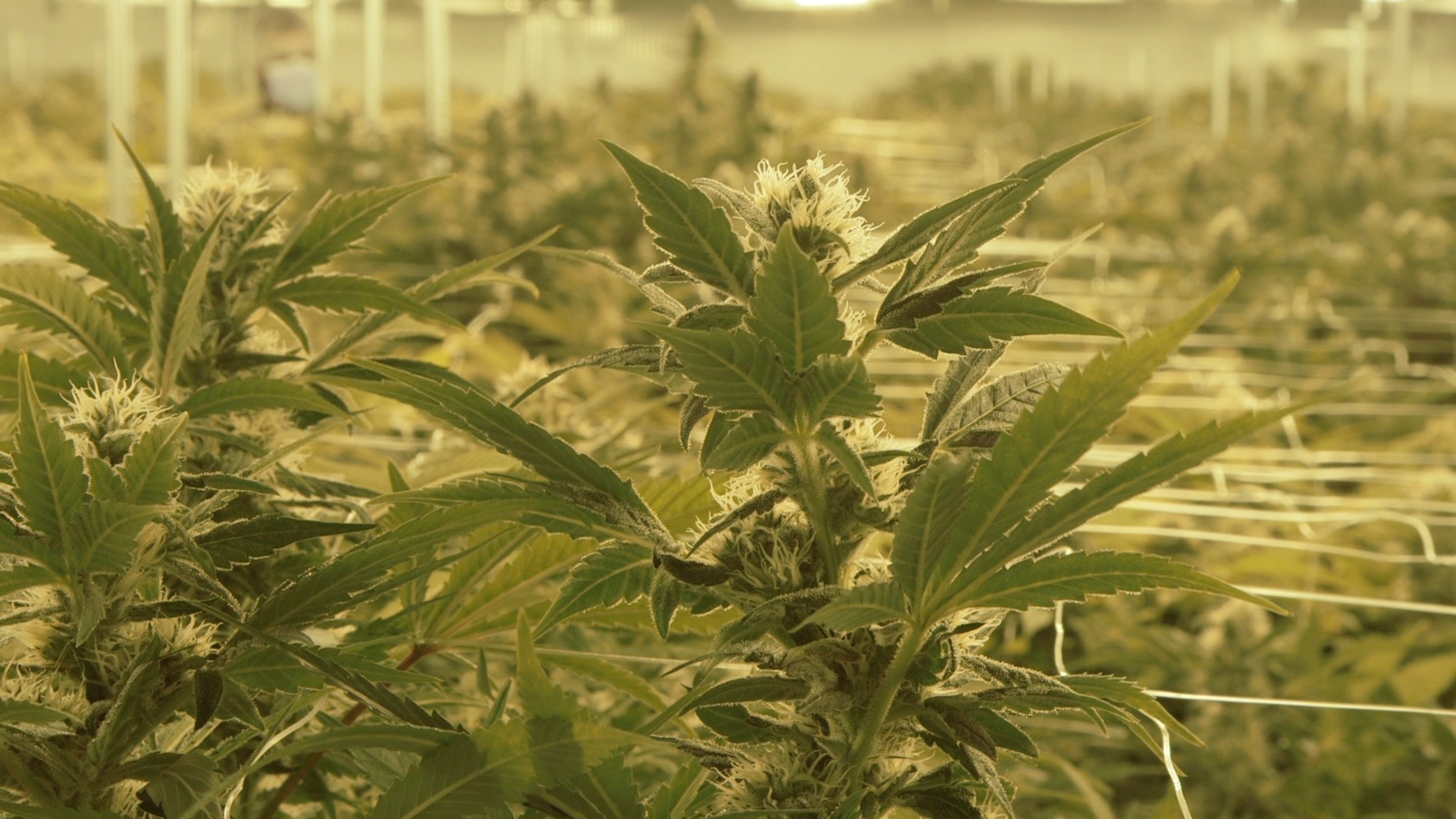Almost everything good is extremely bad for the environment.Binging Netflix. Using disposable chopsticks with your takeout. Washing your clothes after slobbering noodles all over yourself while binging Netflix.Oh, and smoking the joint that started the whole damn mess.Of course, we've known about the environmental impacts of marijuana cultivation for a long while. But now that Canada's Liberal government has finally decided to fulfill one (1) major election promise and legalize weed by July 2018, it will alsohave to start seriously grappling with how to minimize the associated environmental impacts.
Advertisement
"Letting regulators and the public see this as an agricultural crop is really key," said Jake Brenner, associate professor of environmental studies at New York's Ithaca College and researcher of environmental impacts of cannabis agriculture, in an interview with VICE."We treat it like a medicine, we treat it like a drug, but we don't treat it like what it is which is a regular old agricultural crop with a fleet of environmental implications."For one, weed plants are thirsty. A 2016 working document prepared for the Oregon Legislature reported that a single mature weed plant can consume almost 23 litres a water per day, compared to 13 litres for a wine grape plant. That fact matters especially in dry regions and seasons, which we'll likely see extended in the coming decades of climate change.On the plus side, regulating currently illegal operations could help ensure that streams and fish aren't damaged by excessive withdrawals for irrigation, a major problem in California. But the problems go much beyond water.Let's start with artificial indoor operations, which are ideal for growing year-round in many parts of Canada due to the country's frigid winters. The indoor cultivation of weed requires a simply enormous amount of electricity.It makes sense when you think about everything that's required: many high-intensity bulbs, ventilation, dehumidifiers, air conditioners. In fact, a 2012 journal article found that three percent of California's electricity usage goes to powering indoor weed cultivation.
But the problems go much beyond water.Let's start with artificial indoor operations, which are ideal for growing year-round in many parts of Canada due to the country's frigid winters. The indoor cultivation of weed requires a simply enormous amount of electricity.It makes sense when you think about everything that's required: many high-intensity bulbs, ventilation, dehumidifiers, air conditioners. In fact, a 2012 journal article found that three percent of California's electricity usage goes to powering indoor weed cultivation.

Advertisement
Scale that up to the US context and it makes up a full one per cent of the country's total power consumption, equivalent to 15 million tonnes of carbon dioxide per year or the output of seven sizable power plants. That calculates to three pounds of carbon dioxide for every joint, or 4,600 kilograms of pollution for every one kilogram of marijuana."One misperception that folks have is that growing cannabis indoors means they get off without a hitch in regards to the environment," Jennifer Carah, senior freshwater ecologist at The Nature Conservancy in California, told VICE. "That's not really the case."Of course, each Canadian province will have a different ratio of joint-to-pollution ratio, depending on the respective "energy mix."Provinces like Manitoba, Quebec and Newfoundland are almost entirely powered by hydroelectric dams, meaning they could dodge the problem of increased emissions from weed cultivation and perhaps present a lucrative opportunity for investors once the nationally mandated carbon price kicks in.Other provinces like Alberta, Saskatchewan, and Nova Scotia will be using fossil fuels for the foreseeable future; while the transition from coal to natural gas is a positive one from a climate perspective, it still has serious emissions implications (especially if you are remotely skeptical of the exceedingly low methane leakage rates that some provinces assume).
Advertisement
On the bright side, legalizing marijuana will mean that weed growers who were previously attempting to stay hidden by using off-grid electricity from diesel or propane will be able to connect to the relatively cleaner grid and reduce emissions.In addition, greenhouses—which would only need artificial heating during cold nights—become a more viable option, as growers don't need to physically conceal their goods.But say we're talking about one of the unusually warm parts of Canada, such as southwestern Ontario or the southern Gulf Islands in British Columbia. In such places, it's more feasible to grow outdoors for a longer portion of the year. That means that growers don't have to use electricity for bulbs—instead relying on the sun—and effectively eliminates the problem of greenhouse gas emissions.Unfortunately, cultivating outdoors comes with another set of problems.Like with any agricultural crop, an expansion in demand can often lead to increased clearcutting of forests and construction of roads. That in turn can dramatically increase erosion, habitat destruction, river diversion, and forest fragmentation."It can pollute the lands and waters in the areas where it's cultivated, as well as poison wildlife through the use of pesticides, herbicides, fertilizers and petroleum fuels," Carah said.Chemicals are often used to kill woodrats and other small rodents that can damage the crop. Unfortunately, these rodenticides can make their way into the food chain and pose significant risks to predators: Carah says that in California's public lands, put the rare pacific fisher and northern spotted owl in serious danger.
Advertisement
Legalizing and regulating could help mitigate such issues. But weed producers are often opposed to having pesticide use restricted due to severely lower yields. In October 2016, the Denver Post reported that Colorado's lobbying by the marijuana industry significantly weakened state pesticide regulations, with the former agriculture commissioner calling it "the biggest obstacle we had."It's a good example of Brenner's argument that regulating weed isn't a silver bullet to minimizing environmental destruction: "Regulating this like an agricultural crop is a step in the right direction," he said. "I don't know that it's any guarantee that the environmental impacts will disappear."Luckily, other jurisdictions have been trying to figure this out for a while, meaning that Canada can benefit from their learnings. For instance, Boulder, Colorado requires growers to directly offset 100 percent of electricity and other fuels used in production by using renewable energy or paying into an Energy Impact Offset Fund. Utility companies in Oregon have offered cash incentives to reduce energy use.Carah says that upcoming regulations for both medical and recreational marijuana in California will include conditions of licensure which will require compliance with water quality laws. In addition, the state's legalization initiative dedicates 20 percent of tax revenue to preventing environmental impacts and cleaning up environmental impacts of the past.
Advertisement
Over time, there will also be the possibility of Canadian growers tapping into government-led energy efficiency programs and investing in energy-saving technologies such as LED grow lights, as well as plenty of research and development to reduce costs. That could also include proper enforcement of building codes and product labeling. The 2012 journal article estimated that energy usage could be cut by at least 75 percent by applying "cost-effective, commercially-available efficiency improvements."There's also the potential for rural economic development that will replace jobs lost in the national phase-out of coal-fired power."However we can figure out how to bring this under the guise of an environmentally regulatory framework has got to be a good thing because there's a lot of potential there," Brenner said.But let's be real.Smoking marijuana has some environmental downsides. But there are many other far more serious personal behaviours from an environment and climate point of view, such as driving large internal-combustion vehicles like trucks and SUVs, or air travel, or consuming large quantities of factory-farmed meat.Legalizing weed won't be an easy process. But chances are that if done right, it can help mitigate some of the worst byproducts of growing the stuff illegally, especially if politicians are willing to acknowledge that marijuana is here to stay.Follow James Wilt on Twitter.
